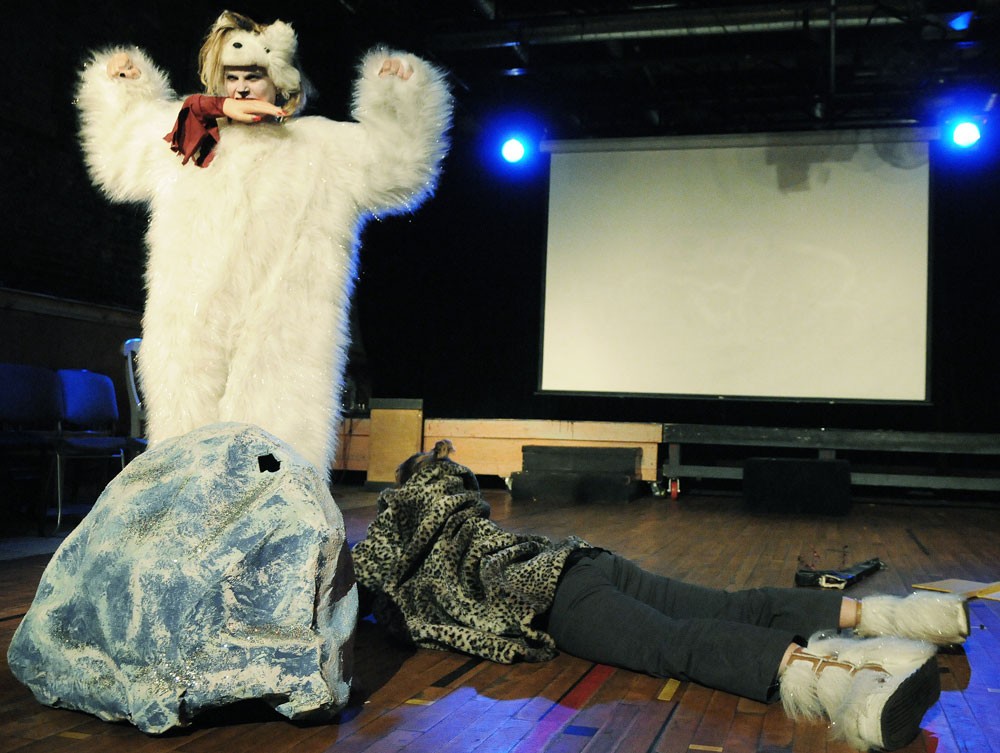For three nights last week, Mina Leierwood was a polar bear. She, along with more than a dozen other individuals and groups, were players in a production at the Bedlam Theatre that encouraged proactive and creative reflection on the contentious and clash-heavy Republican National Convention. Dressed in a white, furry suit with a painted white face and a black nose, Leierwood acted out what she called a polar bearâÄôs fantasy. As a big-haired, fur-coat-clad rendition of Alaska Gov. Sarah Palin emerged from the tiny Bedlam Theatre backstage, Leierwood âÄî the polar bear âÄî grinned and winked at the audience. She lured in the caricatured Palin, promising oil, and pounced, surfacing with a bloody arm in her mouth to audience laughter and applause. Leierwood explained that sheâÄôd spent five hot days in the furry white get-up during the RNC, marching in protests and talking to anyone she could about global warming and a dwindling polar bear population. Bedlam co-artistic director Maren Ward said the project, which ran Thursday, Friday and Saturday nights, was a long time coming. The brainstorming began about six months ago. Ward, from the beginning, had a goal of bringing thoughtful people together post-RNC. Until about a month ago, the plan was to make a play based on peopleâÄôs reflections. But when people came to Ward with their RNC stories and experiences, the projectâÄôs direction took a turn. It became âÄúBecause We Still Live Here,âÄù a conglomeration of separate skits, readings and songs focused on individualsâÄô takes on their time at the RNC. âÄúItâÄôs astounding, the different things people are thinking about,âÄù Ward said. âÄú[I knew] that a lot of people would come, not knowing what to do with this event that just happened.âÄù People packed the small theater each night to see, hear and support the productionâÄôs participants, most of which were protesters, including gay rights advocates and members of Veterans for Peace, among others. Some acts, like LeierwoodâÄôs, were lightheartedly meaningful. Others were more provocative and poignant. One member of the so-called anarchist group, the RNC Welcoming Committee, had a friend read aloud a letter from him. Calling himself only âÄúSome Asshole Who Speaks From Hindsight,âÄù he sharply stressed the importance of organization âÄî a key to fighting off pending protest-related charges âÄî and improved media strategy. But he noted, âÄúAnarchism has now become a household word.âÄù Jude Ortiz , an affiliate of Coldsnap Legal Collective , which offers counsel and legal advice to RNC arrestees, showed a moving slideshow of his time spent alongside âÄúFunk the WarâÄù protesters on Labor Day. As the slideshow, which had twin titles of âÄúFunkedâÄù and âÄúF—-d ,âÄù chronicled OrtizâÄôs experience that day, ending with his arrest and his cameraâÄôs confiscation, he spoke critically of police tactics and praised protester solidarity. âÄúI feel that itâÄôs important for people to see how [police] acted,âÄù he said. âÄúPeople need to see exactly how coordinated the police action is.âÄù Serving as the barrier between police and protesters for the entirety of the convention, Minnesota Peace Team member Carey Heart Borne also spoke. The Minnesota Peace Team is an independent volunteer group aiming to stave off conflict between police and protesters. Heart Borne spoke about the fourth-day protest, where police and protesters squared off in an hour-long stalemate. Police threatened to use disabling chemical agents, but protesters didnâÄôt move. âÄúThat was the place I was feeling my trauma the most,âÄù she said. âÄú[We were] a thin, yellow human buffer between opposing forces.âÄù Following her account, she joined hands with two silent Peace Team colleagues who stood at her side. âÄúIâÄôm still on that bridge,âÄù she said.

Image by Steve Maturen
Mina Leierwood, dressed as a polar bear, bites the hand off of a faux Gov. Sarah Palin during the Bedlam Theatre’s production of “Because We Still Live Here” last Thursday night. “Because We Still Live Here” is a series of ‘creative reflections’ documenting the experiences of various community members during the RNC.
Activists: “We still live here”
Published September 22, 2008
0
More to Discover







